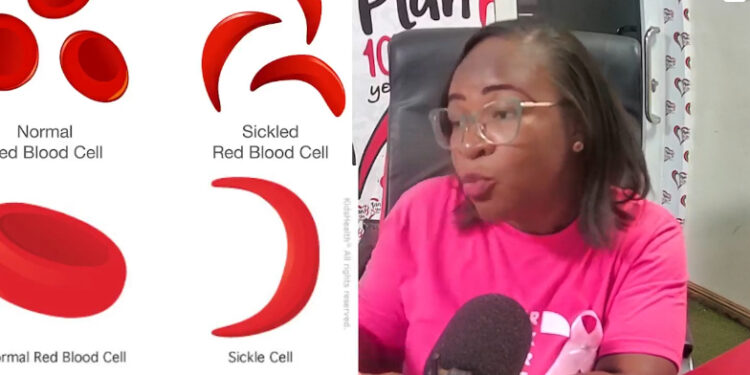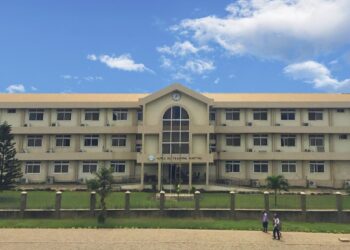Plan B FM’s family, relationship, and lifestyle show dubbed NYANSAPO FIE, hosted by Dr. Michael Asenso, on the topic “SICKLE CELL” with his guests Mrs. Betty Ackon and Mrs. Justina Suapim from Tema Polyclinic explained that sickle cell anemia is one of the group of inherited disorders known as sickle cell disease.
It affects the shape of red blood cells, which carry oxygen to all parts of the body. Red blood cells are usually round and flexible, so they move easily through blood vessels.
In sickle cell anemia, some red blood cells are shaped like sickles or crescent moons. These sickle cells also become rigid and sticky, which can slow or block blood flow.
Mrs. Betty Ackon said, there’s no cure for most people with sickle cell anemia. Treatments can relieve pain and help prevent complications associated with the disease.
She stated that signs and symptoms of sickle cell anemia usually appear around 6 months of age. They vary from person to person and may change over time. Signs and symptoms can include Anemia, sickle cells break apart easily and die. Red blood cells usually live for about 120 days before they need to be replaced. But sickle cells typically die in 10 to 20 days, leaving a shortage of red blood cells (anemia). Without enough red blood cells, the body can’t get enough oxygen and this causes fatigue.
She added that Periodic episodes of extreme pain, called pain crises, are a major symptom of sickle cell anemia. Pain develops when sickle-shaped red blood cells block blood flow through tiny blood vessels to your chest, abdomen, and joints.
The pain varies in intensity and can last for a few hours to a few days. Some people have only a few pain crises a year. Others have a dozen or more a year. A severe pain crisis requires a hospital stay.
Some adolescents and adults with sickle cell anemia also have chronic pain, which can result from bone and joint damage, ulcers, and other causes.
Again swelling of hands and feet is caused by sickle-shaped red blood cells blocking blood circulation in the hands and feet.
Frequent infections. Sickle cells can damage the spleen, increasing vulnerability to infections. Infants and children with sickle cell anemia commonly receive vaccinations and antibiotics to prevent potentially life-threatening infections, such as pneumonia.
Delayed growth or puberty. Red blood cells provide the body with the oxygen and nutrients needed for growth. A shortage of healthy red blood cells can slow growth in infants and children and delay puberty in teenagers.
Vision problems. Tiny blood vessels that supply the eyes can become plugged with sickle cells. This can damage the retina the portion of the eye that processes visual images and lead to vision problems.
Mrs. Justina Suapim also said sickle cell anemia is caused by a change in the gene that tells the body to make the iron-rich compound in red blood cells called hemoglobin. Hemoglobin enables red blood cells to carry oxygen from the lungs throughout the body. The hemoglobin associated with sickle cell anemia causes red blood cells to become rigid, sticky, and misshapen.
She said for a child to be affected, both mother and father must carry one copy of the sickle cell gene also known as sickle cell trait, and pass both copies of the altered form to the child.
“If only one parent passes the sickle cell gene to the child, that child will have the sickle cell trait. With one typical hemoglobin gene and one altered form of the gene, people with the sickle cell trait make both typical hemoglobin and sickle cell hemoglobin, their blood might contain some sickle cells, but they generally don’t have symptoms. They’re carriers of the disease, however, which means they can pass the gene to their children” she added
She said there are complications around sickle cells that can block blood flow to an area of the brain. Signs of stroke include seizures, weakness or numbness of the arms and legs, sudden speech difficulties, and loss of consciousness, a lung infection or sickle cells blocking blood vessels in the lungs can cause this life-threatening complication, resulting in chest pain, fever, and difficulty breathing. It might require.
People with sickle cell anemia can develop high blood pressure in their lungs. This complication usually affects adults and sickle cells block blood flow to organs depriving the affected organs of blood and oxygen. In sickle cell anemia, blood is also chronically low in oxygen. This lack of oxygen-rich blood can damage nerves and organs, including kidneys, liver,r, and spleen, and can be fatal.










Discussion about this post